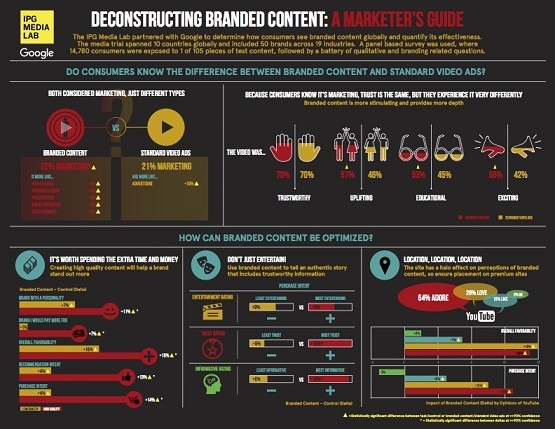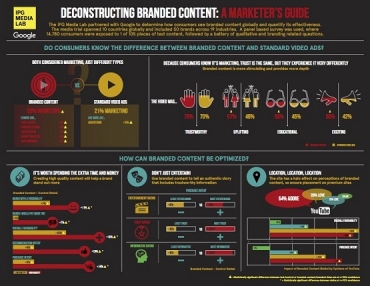

The Global Guide To What Works
Uncovers the Nuances of Digital Content Marketing Effectiveness
Google, in conjunction with the IPG Media Lab, a division of IPG Mediabrands, today announced the results of the industry’s first global comprehensive branded content effectiveness study.
Key findings of the study show:
Consumers have a savvy POV on branded content – they realize it is part of the overall marketing strategy, but see it distinctly different than standard video ads. They view branded content as providing more consumer-centric information, as opposed to brand-centric. They also see branded content as more stimulating and providing more depth than traditional video ads.
Contrary to what marketers might think, the entertainment factor is simply table stakes. Providing content that is trustworthy and informative, while staying authentic to the brand, is much more important for building brand metrics.
Marketers should be thoughtful about where their content lives. The same piece of branded content performs very differently depending on the website on which it appears. In other words, the website has a halo effect on the brand.
Branded content, defined in this research as content that lives on its own, produced by and for the brand, as opposed to content produced by someone else the brand affixes itself to, has transformed marketing, overall. With the increased emphasis on cross-screen viewing, and digital at the core of brand communications, branded content has become a core part of many brand campaigns. This study aimed to understand consumer perceptions and to compare the effectiveness of branded content and video advertising.
“Branded content, in the right context, is a great way for brands to engage with their customers. We see examples of this on YouTube every day, with more brands creating original content like how-to videos and tutorials, or collaborating with a YouTube creator to reach their audience. This research from IPG Media Lab and Google gives marketers some insights into the best ways to incorporate branded content into an overall campaign.” – Torrence Boone, VP, Global Agency Sales & Services.
“Our data indicates there are clear best practices marketers can take advantage of when creating and deploying branded content. Naturally, marketers spend more time and budget creating this custom content, so having these guidelines based on improving brand perceptions and driving purchase intent is invaluable.” – Kara Manatt, VP Consumer Research Strategy.
The closed study surveyed 14,780 consumers, looked at 50 brands, across 19 verticals, in 10 countries, assessing how branded content is perceived in different parts of the world and how this translates into branding effectiveness. This study set out to measure:
Overall favorability
Purchase intent
Recommendation intent
The study also looked at brand perceptions under four lens:
Brands that I would pay more for
Brands that offers valuable information
Brands that with a personality
Brands that I respect
Consumers viewed one of three types of video content 1) video content without any brand mentions, 2) a standard video ad in the form of a pre-roll, followed by video content, or 3) branded content (the average ad length was 130 seconds). After watching the video content, consumers answered a series of questions about the test brand and their perceptions of the video in general.
Consumers know the difference
The study showed that consumers understood that branded content is part of brands’ advertising strategies, however, perceptions varied by country. Consumers in the Middle East were least discerning about branded content, whereas countries such as Portugal, Thailand, Chile and Poland were the most.
Vertical Agnostic – There are opportunities in every category for storytelling, which elevates branded content. A wide range of industries, including CPG, Auto, Telecom and Finance, were able to produce branded content that is differentiated from traditional video ads.
Branded Content Provides Depth– While consumers show similar levels of trust in branded content and standard video ads, branded content is clearly viewed differently – more entertaining, uplifting, educational, novel and exciting.
Increased Persuasiveness and Effectiveness
While the study found that, on average, branded content increases brand favorability by +14% and purchase intent by +9%, the findings go much further by showing how brands can optimize based on:
Level of Quality – high quality content led to +10% greater increase in purchase intent compared to low, indicating it’s worth investing the extra time and effort during the curation phase.
Type of Content – providing trustworthy information was a much stronger driver of effectiveness than other commonly perceived drivers, such as originality and entertainment.
Brand Mentions– while videos with higher levels of branding were more likely to come across as trying to “sell a product,” trust in the information conveyed was the same. Impact on brand metrics was also greater, particularly for high consideration categories, such as auto and finance, where purchase intent was over 4x higher.
Location of Content– premium sites can have a halo effect on preference and intent. The more consumers liked the site, the greater the impact the branded content had on brand KPIs.
